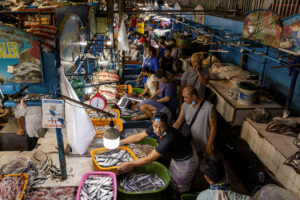By Adrian H. Halili, Reporter
THE Department of Agriculture (DA) said fish imports are calibrated to ensure adequate supply when certain fishing grounds are closed to allow fish species to regenerate.
“Preparations are made prior to the start of the closed fishing season, there is transparency immediately as to how big (the import volumes will be),” Agriculture Assistant Secretary and Spokesperson Arnel V. de Mesa told BusinessWorld.
Last week, the DA approved the import of 25,000 metric tons (MT) of pelagic fish in anticipation of the three-month closed season in key fisheries.
“Kumbaga, hindi ’yung kung kailan may problema na at saka ka pa lang mag-announce ng imports (We don’t wait until the problem is here before announcing imports),” he added.
Under Memorandum Order No. 17, commercial fishing operations are allocated 80% or 20,000 MT, with the remaining 20% or 5,000 MT going to fisheries associations or cooperatives.
“The only good thing about it now is that it can be programmed right away. Because fisheries will close again by Nov. 1 in North East Palawan, and by Nov. 15 in the Visayas,” Mr. De Mesa said.
The fisheries where closed seasons are declared late in the year include northern Palawan, Ilocos, Negros Occidental, Capiz, and Cebu.
Sardine fishing is not allowed in northern Palawan between Nov. 1 and Jan. 31. Herring and mackerel cannot be caught in the Visayan Sea between Nov. 15 and Feb. 15.
Closed seasons are authorized by Republic Act No. 8550 or the Fisheries Code.
Last year, the department approved fish imports of 35,000 MT for sale in wet markets.
David B. Villaluz, chairman of the Philippine Association of Fish Producers, Inc. said that the DA’s importation plan may end up competing with aquaculture products.
“This is disadvantageous to aquaculture during the latter parts of the year. Duon kami bumabawi, dun magpro-produce ang aquaculture to offset supply during the closed fishing season, (That’s when we make up for the slower parts of the year. That’s when we hope to produce more when closed fishing season brings down supply),” Mr. Villaluz told BusinessWorld by phone.
In 2023, fisheries production dropped 6.5%, accelerating the 5% decline recorded in the prior year, according to the Philippine Statistics Authority.
Agriculture Secretary Francisco P. Tiu Laurel, Jr. has said that fish imports must arrive before Jan. 15.
